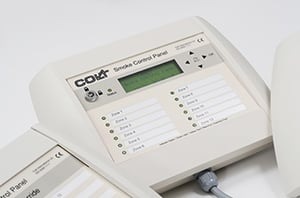Part 3 - Opening up the Closed Protocol Debate
 Control systems for smoke ventilation need to meet the demand for increasing complexity of modern building complexes, such as large-scale residential schemes or high-rise tower buildings. As a property owner or developer, when making your choice of a fire alarm control system for your building, you will have to decide between an HVAC/BMS control system or one specifically designed for smoke ventilation, and between open or closed protocol.
Control systems for smoke ventilation need to meet the demand for increasing complexity of modern building complexes, such as large-scale residential schemes or high-rise tower buildings. As a property owner or developer, when making your choice of a fire alarm control system for your building, you will have to decide between an HVAC/BMS control system or one specifically designed for smoke ventilation, and between open or closed protocol.
As you make your considerations, it is important to keep in mind the key requirements your control system has to meet.
- Robustness and reliability are paramount.
- Self-monitoring. The control system should be constantly checking for failure and instigate a restart if it senses imminent failure. Importantly, when it has re-started, the system should remember what it was doing before the crash.
- Network integrity. The system should monitor both the communications around the network and the devices themselves to ensure full network integrity. When it loses communications with a device on the network, it should activate an alarm should and the device lost should default to a failsafe position or in its current state, depending on the system design.
- No deviation from first incident. When the system receives an input, it should retain a cause and effect and follow it without deviating if it receives a second input. Smoke ventilation systems are generally designed for one fire incident at any one time and should only act on the first incident detected, locking out all subsequent events.
- Continued operation during power cuts. The system should be able to continue operating even in the event of primary power failure.
- Compartmentalisation. If the system serves multiple fire compartments, only the compartment on fire should be vented, all others should remain separated.
- Override facility. There should be a facility for the Fire Service to override the operation of the system by setting it into action, or stopping it, or re-setting it into a different mode of operation.
Most smoke control systems are designed for life safety purposes, so to perform effectively, these are the functionalities you can’t do without. If your smoke control system is required to interface with a BMS, I would strongly recommend that the BMS has no control over the network – it should only read the data.
Colt OPV delivers all these requirements – read more about it.
Article 1: What are controls protocols?
Article 2: Reducing complexity in smoke ventilation systems controls
 Conor Logan is a Technical Manager of Colt UK, Smoke and Climate Control Division. Conor designs innovative smoke control and HVAC systems and is also Chairman of the Smoke Control Association.
Conor Logan is a Technical Manager of Colt UK, Smoke and Climate Control Division. Conor designs innovative smoke control and HVAC systems and is also Chairman of the Smoke Control Association.


